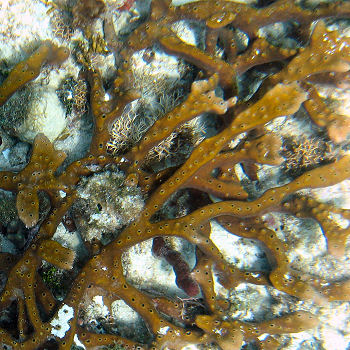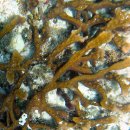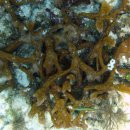Haplosclerida, Petrosiidae


|

|

|
| Common Name(s): | None |
| Growth Form: | Solid branches, often interconnecting, tending to run along the substrate. Individual branches up to 28 cm long, 2.5 cm wide, may be somewhat flattened and wider at the tips. |
| Surface: | Smooth, flat. |
| Color: | Brown, orange or yellow, sometimes with greenish tones outside. Tan, off-white inside. |
| Consistency: | Hard, brittle. |
| Oscules: | Round, 2-4 mm across; flush or on conical elevations up to 1.3 cm tall; surrounded by a paler (often yellow) membrane; usually arranged more or less linearly on upper surface of branches; sometimes fused to form a crest. |
| Skeletal components (Spicules, fibers): | Slightly curved rods with both ends pointed (oxea) or with 2 distinctly tapering rounded ends (strongyloxea) μm. Tips gradual, abrupt, stepped or with a nipple. No spongin. |
| Skeletal architecture: | Surface reticulation of spicule tracts of single or multiple spicules, sometimes confused; tracts up to 90 μm across; meshes triangular to polygonal, 30-550 μm. Numerous spicules stick out of surface. Interior characteristically dense and solid with numerous radiating canals 230-460 μm across, visible to the naked eye; exhalant canals up to 1.5 mm across, arising from center of branches and converging under oscules; multispicular tracts (3->10 spicules across; 46-65 μm in diameter) ascending from branch axis, radiating toward surface, irregularly interconnected by smaller tracts (single or multiple spicules); meshes rectangular to rounded, 80-260 μm across. Many loose spicules make the central and subsurface skeleton very dense and confused. |
| Ecology: | On reefs, especially in sand channels where water tends to be more turbid. |
| Distribution: | West and east coasts of Florida, Bahamas, and throughout Caribbean. |
| Notes: | Specimen fits well description in the literature. |
| Reference(s): | Zea (1987). |